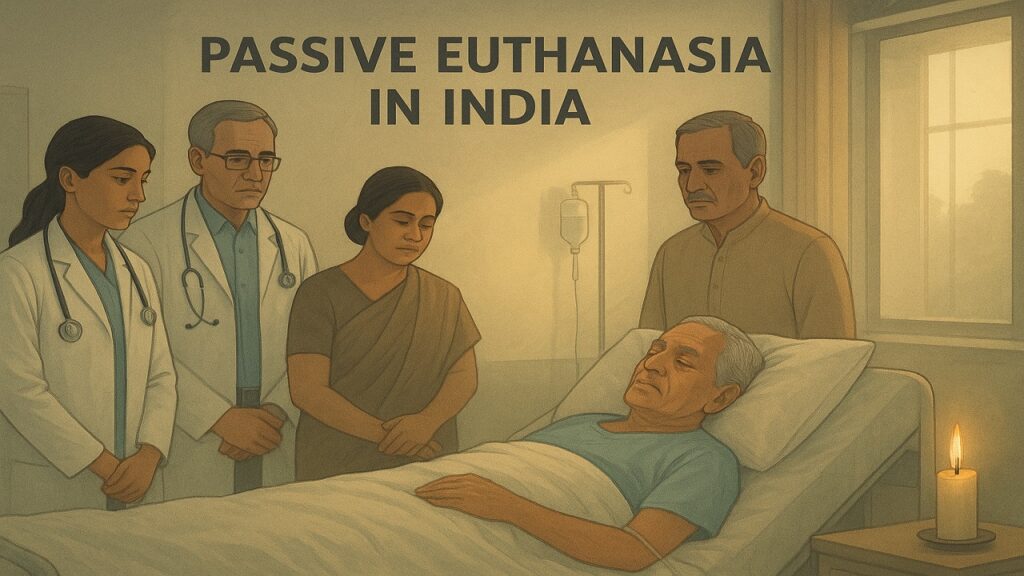Passive Euthanasia in India : Humanising the Right to Die with Dignity
context :

The recent debate in the U.K. Parliament on the Terminally Ill Adults (End of Life) Bill, 2025 has once again brought global attention to the ethics of dying. While some countries explore legalising active euthanasia, for India the focus lies on strengthening and reforming the framework for passive euthanasia.
The challenge is to make the system humane, transparent, and accessible, ensuring that the right to die with dignity is not just theoretical but practically enforceable.
What is Passive Euthanasia?
- Definition: Withdrawal or withholding of life-support or medical treatment when a terminally ill patient has no realistic chance of recovery.
- Purpose: Ensures the right to die with dignity and prevents prolonged suffering in irreversible medical conditions.
Judicial Evolution in India
Early Position
- Until 2011, euthanasia was illegal.
- Section 309, IPC criminalised attempt to suicide.
Aruna Shanbaug v. Union of India (2011)
- Recognised passive euthanasia under judicial supervision.
- Allowed withdrawal of life support in exceptional cases with High Court approval.
- Distinguished between active euthanasia (illegal) and passive euthanasia (conditionally legal).
- Stressed that life without dignity is not constitutionally protected.
Common Cause v. Union of India (2018)
- Legalised advance directives (living wills).
- Declared Right to Die with Dignity as part of Article 21.
- Issued detailed guidelines for authorising passive euthanasia.
Current Legal Procedure (SC Guidelines, 2018 – modified 2023)
Advance Directive (Living Will)
- Any adult of sound mind may record a living will.
- Must be signed before two witnesses and attested by a Judicial Magistrate First Class (JMFC).
Medical Scrutiny
- A primary board of three senior doctors certifies irreversibility.
- Reviewed by a secondary board under the CMO.
Judicial Oversight
- JMFC verifies authenticity of the living will and medical opinions.
If No Living Will Exists
- Family or doctors may seek court permission, subject to the same scrutiny.
Simplification (SC Order, Jan 2023)
- Removed district collector approval.
- Empowered hospital ethics committees for faster decisions.
- Retained double medical-board review for safety.
Why the Current System Fails
- Bureaucratic Delays – Multiple approvals defeat the purpose of timely relief.
- Lack of Awareness – Citizens and even doctors are often unaware of legal provisions.
- Ethical Dilemmas – Families face moral guilt and financial pressure.
- Healthcare Inequality – Small hospitals lack ethics committees, creating uneven access.
- Fear of Prosecution – Doctors hesitate due to uncertainty under IPC 309 and medical negligence laws.
Ethical and Constitutional Dimensions
- Article 21 – Right to Life includes freedom from prolonged, undignified suffering.
- Ethical Principles – Balances autonomy (self-determination) and non-maleficence (avoiding harm).
- Judicial Caution – Courts carefully distinguish between allowing death and causing death.
- Cultural Philosophy – Indian thought recognises death as a natural stage of existence, encouraging acceptance.
- State’s Duty – Under Article 47, government must provide palliative and end-of-life care as part of public health.
Comparative Perspective
- Global Models: U.K. and Netherlands depend on robust healthcare and strict monitoring.
- Indian Reality: Requires simplification, clarity, and institutional capacity before any expansion.
- Balanced Approach: Strengthen passive euthanasia framework rather than legalising active euthanasia.
Way Forward: Reforming the Framework
Digital Advance Directives
- Launch National Euthanasia Portal linked with Aadhaar for registering and authenticating living wills.
- Allow online filing, modification, or withdrawal with doctor certification.
Hospital-Level Ethics Committees
- Panels with senior physicians, palliative experts, and an independent member.
- Decisions within 48 hours to ensure timeliness.
Transparent Oversight
- State health commissioners or digital dashboards for monitoring.
- Random audits and public reports to ensure accountability.
Mandatory Safeguards
- 7-day cooling-off period with counselling for patients and families.
- Palliative-care review to prevent coercion or financial pressure.
Capacity Building & Awareness
- Introduce end-of-life ethics in medical education.
- Conduct public campaigns on living wills and palliative care.
- Involve NGOs and local health missions for community engagement.
Conclusion
India’s approach to euthanasia must be guided by legality with humanity. The goal is not to legalise death, but to humanise dying—where the law safeguards compassion, dignity, and autonomy.
By adopting digital tools, strengthening ethics committees, and spreading public awareness, India can transform passive euthanasia from a distant legal concept into a humane, workable, and constitutionally sound reality.
Source : The Hindu
